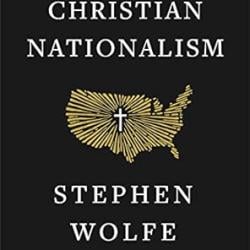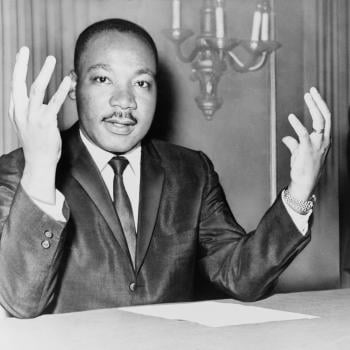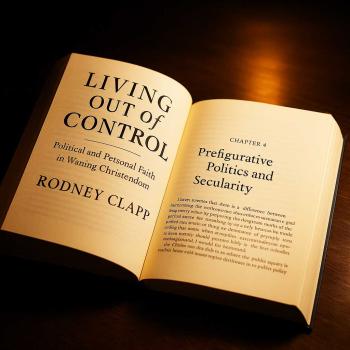A Good New Book: A Missional Orthodoxy: Theology And Ministry in a Post-Christian Context by Gary Tyra (InterVarsity Press, 2013).
This book is hefty but it packs a good and needed “punch.” For evangelicals interested in being both missional and orthodox at the same time, it’s a breath of fresh air. One of the book’s central theses, maybe its main thesis, is that too many especially younger evangelicals think they have to choose between being either missional or orthodox.
Tyra is associate professor of biblical and practical theology at Assemblies of God related Vanguard University of Southern California (formerly Southern California College). However, he does not promote Pentecostal theology in this book (or any other that I know of). I say this so that readers who know Tyra teaches at an AG university won’t dismiss the book as “Pentecostal theology.” Nothing in it conflicts with sound, evangelical Pentecostal theology, but its orientation is broader. I would call it progressive evangelical but rooted in biblical and ecumenical orthodoxy.
Tyra chooses two contemporary theologians as his foils or case studies for how not to be both missional and orthodox. By the end of the book it is clear that he is warning evangelicals to beware of the trajectory he perceives much of the emerging church movement to be on. His case study of this trajectory is Brian McLaren and especially his later writings (e.g., Why Did Jesus, Moses, the Buddha, and Mohammed Cross the Road? Christian Identity in a Multi-Faith World). His case study of outright, blatant unorthodox liberal theology, toward which he fears McLaren and others in the emerging church movement are moving, is Marcus Borg and especially his book The Heart of Christianity: Rediscovering a Life of Faith.
Throughout the book Tyra compares Borg and McLaren. Borg denies theistic realism, preferring a symbolic realism in which symbols and images that transform are more important and valuable for Christianity than historical events and doctrines. He embraces soteriological pluralism in which Jesus Christ is “our savior” but not “the only savior.” Borg is generally considered by all evangelicals to be one of the purest examples of classical but contemporary liberal theology—along with John Shelby Spong. (I mention them because they are scholarly popularizers of liberal theology whose books can generally be found in mainstream bookstores.)
Tyra makes clear that he does not think McLaren is yet where Borg is, but his comparisons of the two theologians demonstrate a trajectory that leads him to think McLaren will, if he keeps going in the same direction, end up where Borg is now. The difference is that McLaren does not deny key biblical and orthodox doctrines, but he does minimize their importance to almost a vanishing point (according to Tyra). Tyra’s thesis is that McLaren is flirting with the danger of throwing the baby of basic Christian orthodoxy (defined Christologically) out with the bathwater of fundamentalism (his own spiritual and theological background to which he is [over]reacting). The Borg quotes he juxtaposes with McLaren’s indicate that perhaps McLaren is overly inspired by Borg. Or perhaps he is simply thinking along the same lines so that, eventually, he may end up where Borg is.
This is one case, I think, where a slippery slope argument is couched so cautiously and demonstrated so voluminously that it carries some weight. Tyra does not say Borg and McLaren are brothers under the skin or bedfellows theologically, but he does cautiously warn that McLaren’s movement is in Borg’s direction and that this is not healthy because, somewhere along the way, authentic Christianity gets jettissoned in favor of a bland, insipid, culturally accommodated liberalism. Tyra’s message to young, missionally-minded evangelicals (or post-evangelicals) is to beware of following McLaren too far. He does not, in fundamentalist fashion, suggest they not read McLaren (or Borg, for that matter). He is very irenic and cautious in his warnings—making clear that he respects both men, especially McLaren, but worries about their theologies and their effects in the churches.
Tyra goes through the gamut of Christian doctrines, from methodology to eschatology, urging contextualization of the gospel without assimilation to culture. He agrees with much of what Borg and McLaren affirm while gently but firmly disagreeing with much of what they deny (orthodoxy in Borg’s case and the important of orthodoxy in McLaren’s case).
Fundamentalists who read Tyra’s book will think he goes too far in revising what they consider biblical orthodoxy. He affirms inspiration without inerrancy (unless “inerrancy” is defined so broadly that it loses its meaning), atoning sacrifice of Christ without penal substitution, and kenotic Christology. And he argues very strenuously that Christians ought to avoid imposing Christianity on people in a totalizing manner.
Liberals who read Tyra’s book will think he is a fundamentalist because he affirms the supernatural, miracles, the unique inspiration and authority of the Bible, the incarnation of God in Jesus Christ (in more than a symbolic or functional sense), Jesus’ bodily resurrection and his return in glory.
But all Tyra’s requires for “orthodoxy” is four “Christological verities”—the main one being the incarnation, that Jesus Christ was and is both truly God and truly human.
Don’t imagine, however, that Tyra’s book is all negative. He transcends critique (of Borg and McLaren) to affirmation—of the church as missional in the sense of existing for the mission of God in the world (as opposed to existing for its own maintenance and glory).
So who are Tyra’s “heroes?” He relies heavily on Lesslie Newbigin and Darrell Guder—two heroes of “missional Christianity.” Neither was/is a fundamentalist. Both argued/argue for contextualization of the gospel without assimilation to culture (especially modernity).
One strength of Tyra’s book is its cautious, often even sympathetic, critiques of Borg and McLaren and others who, with good intentions, over react to fundamentalism. There is no hint of mean-spiritedness in Tyra’s book. If anything he bends over backwards to be irenic, generous and kind.
Another strength is the book’s detailed analysis of contemporary “postmodern” Christianity in all its varieties. He demonstrates the differences as well as the similarities (mainly of concern).
I think a major strength of the book is its emphasis on and call for balance—not throwing babies out with bathwater but finding and holding steady to basic, broad orthodoxy while rejecting narrow fundamentalism.
One obvious weakness (for many potential readers) of the book is its size (393 pages). However, I think it’s worth it. I read it twice—the second time in one day.
Another possible weakness is the “kid gloves” with which Tyra handles Borg and McLaren. Several readers have told me they think he needed to take off the gloves and be bolder in his assertions (e.g., say that Borg is a heretic). On the other hand, some readers think he is too critical of McLaren. So the weakness may be a tendency to pull punches where a few punches might be in order and even helpful to readers in discerning the point.
I highly recommend A Missional Orthodoxy to all readers interested in the contemporary Christian theological “scene” in America—especially the “scene” on bookshelves of theologically-minded non-scholars who are being swayed and influenced by popularizers such as Borg and McLaren.












